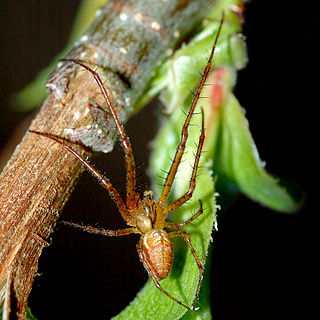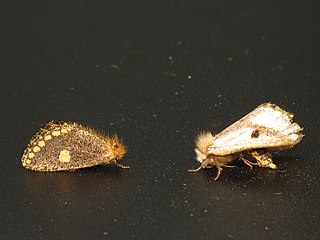
Long-jawed orb weavers or long jawed spiders (Tetragnathidae) is a family of araneomorph spiders first described by Anton Menge in 1866. They have elongated bodies, legs, and chelicerae, and build small orb webs with an open hub with few, wide-set radii and spirals with no signal line or retreat. Some species are often found in long vegetation near water.

Earias is a genus of moths in the monotypic subfamily Eariadinae of the family Nolidae. The genus was erected by Jacob Hübner in 1825. Species are found throughout Europe, Africa, Asia and Australia, some being agricultural pests such as bollworms.

Grevillea venusta, commonly known as the Byfield spider flower, is a woody shrub of the family Proteaceae native to a small region of central Queensland in eastern Australia. It has bright green leaves and unusually coloured green, gold and blackish inflorescences.
Stenoscaptia is a genus of moths in the family Erebidae.

Metallochlora is a genus of moths in the family Geometridae described by Warren in 1896.

Dioptinae is a subfamily of the moth family Notodontidae.

Lichenaula is a genus of Australian moth of the family Xyloryctidae.

Xyloryctidae is a family of moths contained within the superfamily Gelechioidea described by Edward Meyrick in 1890. Most genera are found in the Indo-Australian region. While many of these moths are tiny, some members of the family grow to a wingspan of up to 66 mm, making them giants among the micromoths.
Aeolochroma turneri is a moth of the family Geometridae first described by Thomas Pennington Lucas in 1890. It is found in Australia's Northern Territory and Queensland.
Aeolochroma viridicata is a moth of the family Geometridae first described by Thomas Pennington Lucas in 1890. It is found in Australian states of New South Wales and Queensland. Adultsts have a complex green and brown or grey pattern.
Eressa angustipenna, the black-headed wasp moth, is a moth of the family Erebidae. It was described by Thomas Pennington Lucas in 1890. It is found in Australia, as well as the Philippines.
Halone interspersa is a moth of the subfamily Arctiinae. It was described by Thomas Pennington Lucas in 1890. It is found in Australia.
Lambula transcripta is a moth of the family Erebidae. It was described by Thomas Pennington Lucas in 1890. It is found in Queensland, Australia.
Lepista pulverulenta is a moth of the subfamily Arctiinae. It was described by Thomas Pennington Lucas in 1890. It is found in Australia, where it has been recorded from Queensland.
Giaura punctata is a moth in the family Nolidae. It was described by Thomas Pennington Lucas in 1890. It is found on the Bismarck Islands and on New Guinea and Australia.
Stenoscaptia aroa is a moth in the family Erebidae. It is found in New Guinea.
Stenoscaptia latifascia is a moth in the family Erebidae. It is found on Volcan Island.
The Nudariina are a subtribe of lichen moths in the family Erebidae. The taxon was described by Carl Julius Bernhard Börner in 1920.

Epicoma protrahens is a processional moth of the family Thaumetopoeidae first described by Thomas Pennington Lucas in 1890. It is found on the east coast of Australia.






